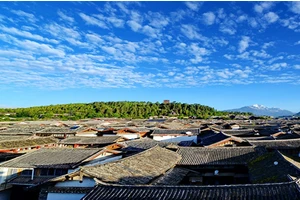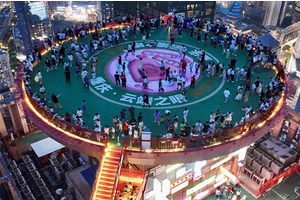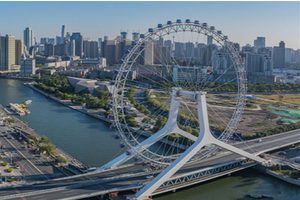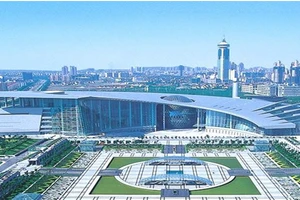Xichang self-driving travel guide
The tourist attractions in Xichang include Qionghai Wetland Park, Luoji Mountain Scenic Area, Gukede National Wetland Park, Lushan Mountain and Xianren Cave in Anhayizhai.
1. Qionghai Wetland Park
Qionghai National Wetland Park is a plateau wetland nature reserve with high ecological value approved by the State Forestry Administration. It is located in Xichang City, the state capital of Liangshan Yi Autonomous Prefecture, Sichuan Province, known as an american in china City, China Aerospace City and Xiaochun City. It is the largest urban wetland park with a total wetland area of about 20,000 mu, which has multiple functions of conserving water, regulating urban microclimate, purifying water quality and providing animal and plant habitats and ecological landscapes.
2. Luoji Mountain Scenic Area
Luoji Mountain Scenic Area, also known as Luoji Mountain Scenic Area, Luoji Mountain Scenic Area and Luoji Mountain Scenic Area, is located in Luoji Mountain Town, Puge County, Liangshan Yi Autonomous Prefecture, Sichuan Province, across Puge, Dechang and Xichang counties and one city. It is a part of Qionghai-Luoji Mountain Scenic Area, and also the largest Yi inhabited area in China, with quaint folk customs and culture.
3. Gukede National Wetland Park
Sichuan Daliangshan Gukede National Wetland Park is located in Nidi Township and Wanchang Township of Zhaojue County, with a planned total area of 697.7 hectares, of which the wetland area is 343.5 hectares and the wetland rate is 49.23%. The main wetland resources are swampy meadow wetlands formed in local low-lying areas of intermountain basins and shrub swamp wetlands around them, as well as several alpine moraine lakes and affiliated river wetland systems, which embodies the uniqueness and representativeness of subalpine swamp wetlands in the eastern margin of Hengduan.
4. Lushan Mountain
Lushan Mountain, which is on the verge of Qionghai and rises from the ground, constitutes a major scenic spot in southwest Sichuan with the momentum of "half supporting the Xiao Han and Ningcheng painting the screen", and is known as "the scenic spot in south Sichuan". Lushan Mountain, also known as Frog Mountain, is one of the provincial scenic spots in Sichuan. Lushan elevation is 2317 meters. It faces Qionghai in the east, Anning River in the west, Xichang in the north and Luoji Mountain in the south.
5. Xianren Cave in Anhayi Village
Anha Yizhai Xianren Cave Scenic Spot is a national AAAA-level scenic spot, located in Anha Town, Xichang City, Liangshan Prefecture, Sichuan Province. It is mainly composed of Yijiaxinzhai, self-driving camp and Xianren Cave, and its tourism projects are characterized by "folk customs tour, ecological leisure tour and fitness adventure tour". Anha Yi Village takes the original ecological folk customs of "Luoling Yi Style" as the theme, with three festivals as highlights: Pear Blossom Festival, Torch Festival and Yi New Year Food Festival.
The above contents refer to Baidu Encyclopedia-Qionghai National Wetland Park.
Liangshan Prefecture, located in the southwest of Sichuan Province, has a subtropical monsoon climate. Liangshan has been an important gateway to Yunnan and Southeast Asia since ancient times, with 9 4A-level scenic spots, including Qionghai-Lushan, Luoji Mountain, Lugu Lake and xichang satellite launch center. So, what's interesting about going to Liangshan? Let's take a look with Xiaobian.
brief introduction
Liangshan Yi Autonomous Prefecture is located in the southwest of Sichuan Province, facing Yunnan Province across the Jinsha River in the southeast, and Xichang City, the state capital, is located in the middle of chengdu-kunming railway. Since ancient times, it has been an important town of the "Southern Silk Road" leading to Yunnan and Southeast Asia. Xichang is also known as the "Moon City", where xichang satellite launch center is located, and it is a world-famous space city. There are more than 10 ethnic groups living in China, including Han, Yi, Tibetan, Mongolian and Naxi, and it is the largest Yi community in China. Here, there is no severe cold in winter, no intense heat in summer, and the four seasons are like spring, enjoying the reputation of "colorful flowers bloom, warm in winter and cool in summer". The territory is rich in ethnic and regional characteristics, and the folk customs are simple and colorful, such as the unique folk customs of the Yi people and the custom of "leaving marriage" of the Mosuo people along Lugu Lake. Rich in tourism resources, there are Lugu Lake, Luoji Mountain, Xichang Ancient City, Qionghai Dafengding Nature Reserve, Leiboma Lake Scenic Area, Huili Ancient City and other tourist attractions.
Optimal travel time
Four seasons are suitable
Liangshan tourism recommendation
Go on road trip: Xichang-Yanyuan-Muli.
Main attractions: Yihai, Lingshan Temple, Qionghai, Lushan, Gongmushan, Lugu Lake, Changhaizi, Shuiluohe and Chengdu.
Go on road trip: Chengdu-Leibo-Meigu-Zhaojue-Xichang
Main attractions and customs: Leiboma Lake Provincial Scenic Area, Xiluodu Giant Water Conservancy Project in Jinsha River, Meigu Dafeng Ding Nature Reserve, Meigu Bimo Cultural Customs, Zhaojue Bamboo Hot Springs, Zhaojue Yi People's Costume Cultural Exhibition, Qiliba Plateau Scenery, Boshiwa Black Rock Painting in Late Tang Dynasty, and Aerial Seeding Forest Area.
Go on road trip: Chengdu-Ganluo-Yuexi-Mianning.
Main attractions and customs: Dadu River Gorge, Pubugou Power Station, Maanshan Nature Reserve, Ganluotian Bahai Ancient Town, Lingguan Ancient Road, Xiaonanhai Scenery in Western Vietnam, Nanqinggou Scenery, Zhongsuo Watertown Scenery, Xide Xiaoxiangling Scenery, Mianning Yihai, Daqiao Reservoir and Red Army Square.
Go on road trip, Changzheng Road, Red Army, Southern Line: Mianning-Xichang-Dechang-Huili-Puge, Chengdu
Main attractions: Daqiao Reservoir, Lugu Gorge, Dressing Table, Lizhou Ancient Town, Xianren Cave, Luoji Mountain, Huanglian Tulin, Stone Tomb of Anning River, Dongping Han Dynasty Coin Site, Huili Longjiao Mountain, Red Army Long March Memorial Hall, Huili Conference Site, Huili Ancient City, and Jiaopingdu of Jinsha River.
Recommendation of Liangshan tourist attractions
Zouhun bridge
The most famous bridge in Caohai is Zouhun Bridge, which is known as "the first magpie bridge in the world". It is a 300-meter-long wooden bridge extending from the reeds in Caohai. Part of the wood of the old bridge with a history of nearly a hundred years has rotted or been destroyed and scattered in the grass sea. Now this bridge is adjacent to the old bridge and was rebuilt later. The Zouhun Bridge crosses the Caohai, the Lucong and the villages on both sides of the strait, providing a convenient passage for the villagers on both sides of the strait and the "Axia" who are "married".
Lushan Qionghai scenic spot
Qianqionghai has been planned as a national wetland park, and the scenic area mainly includes bird watching island, Mengli water town, Yanyu Luzhou and Xibo Heying. The sculpture of a girl sitting on the moon by the sea is a landmark building in the town. You can reach the bay area through Qionghai Park, and you can overlook the whole Qionghai in morning exercises. Whether it's staying by the lake for a weekend, boating and tasting the lake, or renting a bicycle to go around the lake for a week, it's a good experience.
Luojishan scenic spot
Luoji Mountain is a rare and intact natural museum of Quaternary ancient glaciers in the known mountainous areas in China, and it is also an early Buddhist shrine in history. Luoji Mountain is a good time to travel all year round, with sunny weather, especially in summer. Every April and May, azaleas are in full bloom. At this time, you can see the Rhododendron Sea. There is the longest ropeway in Asia. After climbing to the top of the mountain, you can overlook the world's largest ancient ice groove and alpine lakes, and you can enjoy the unique local Yi flower drum dance at night. It is suggested to get up early when going to Luoji Mountain, because Luoji Mountain is also crowded during holidays. It's windy at the top of the mountain, so you need to take a warm coat when you go up the mountain.






